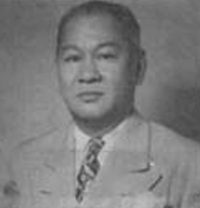Ynoy Junsay, Camique and Sisoy found their way to Panay unmolested. They left at midnight last night. May God be with them.
Where are the Japs going to fight in Central Luzon? I have a hunch that these brutes would use the civilians in the City of Manila to shield themselves. In Manila, these damned fools, I surmise, would make their last stand, knowing that in the open field of Tarlac and Pampanga, they are no match to the American legion of liberation.
After all that was being bruited around that Pres. Osmeña in a radio address was sort of trying to court the favor of puppets, the full text of the address reveals the contrary. He just appealed for an orderly and dignified procedure in handling them.
The Japs have found the air support of the American forces too much for them. That’s why the former haven’t so far put up a respectable resistance.
The Japs are now getting their own medicine.
I have just met old man Zayco—a figure in the economic and political life of Kabancalan. I met him a year or two before the war. What a contrast between the outward appearance of Zayco then and now!
Now he lives in the nuts—as a staunch supporter of the guerilla. He wears an old checkered outshirt in black and white, “maong” short pants and a wide-brimmed pandan and buri leaf hat. He wears no shoes. He is tall and quite lean. His head is almost bald, with a receding forehead. His face is sharp and his hair is cut short. His shoulders are slightly bent—carrying 64 years on them. Yet he is light on his feet. His eyes are still clear and keen. Should you meet him casually, you would take him to be a storm-beaten fisherman that goes out every day on his little banca to eke out his living from the sea. In other words, you would take him as nobody.
Had you seen Zayco during pre-war days, you wouldn’t or couldn’t believe that this is the same man. He had his home among the best in his community. He rubbed shoulders with the mightiest therein. He had more than enough in his own name. He was a power among his townfolks. His views on all public questions had to be reckoned with. He lived in comparative comfort. He had his private car and servants.
He has thrown his lot with the guerilla—and lives the life of the guerillero. That’s why Zayco, who had a private car at his disposal in pre-war times, now goes barefoot, footing distances going over hills and mountains without complaint but with pride.
To me Zayco symbolizes the true spirit of the guerilla. He demonstrates that, for a principle, he can successfully forego a life of ease and absorb the inconveniences that guerilla life entails, without destroying his soul. Zayco’s voice has still the ring of one who continues to enjoy life, and feels the thrill of living dangerously for a good cause.
I take off my hat to Zayco. He has my admiration and respect. He is a better, worthier citizen than any of the most talented of any Jap collaborator.
I am happy that I have met him as he is today.
It is very inspiring to see a Filipino priest throwing his lot with the guerilla, partaking in all its trials and tribulations. Father Frondesa, a young religious, is this man. He told me “as long as there is a single Filipino soldier in the guerilla, I am going to stand by him to the end.” Why could not all our Filipino priests take the same grim determination for the course? He certainly saves our priesthood from complete disgrace.
With the Russian mammoth and titanic offensive unequalled and unprecedented in all history, I see an early defeat of Germany, now being pinched by the terribly formidable forces of these sledge hammer blows against her vital position.
Koisio would be stepping out soon for fresh air, should Manila fall, or even before this eventuality. But change of personnel in the Japanese cabinet would not sever the course of war. It would be attempting what King Canute failed to do with the tide.
I found the address of Pres. Osmeña on Dec. 23, 1944 not bad at all. On the contrary, it’s of high quality of statesmanship.
